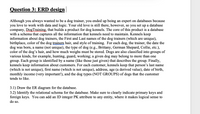
Question 3: ERD design
Although you always wanted to be a dog trainer, you ended up being an expert on databases because you love to work with data and logic. Your old love is still there, however, so you set up a
3.1) Draw the ER diagram for the database.
3.2) Identify the relational schema for the database. Make sure to clearly indicate primary keys and foreign keys. You can add an ID integer PK attribute to any entity, where it makes logical sense to do so.

Trending nowThis is a popular solution!
Step by stepSolved in 3 steps with 2 images

- suppose you are planning to develop a database where you store information about the students, courses and student grades. This is a very simple database - but would help us to learn several important concepts. How would you design and implement the database?arrow_forwardAlthough there are many more than three, please define just three elements (items, pieces) other than "tables" that are a part of every database, from a real estate agency, to a school, or grocery store, or ANY database: 1. definition: 2. definition: definition: 3.arrow_forwardThere are many advantages to utilizing a hierarchical database as opposed to a relational database.Whether or whether the aforementioned assertion is accurate is what you should discuss.arrow_forward
- Database Systems: Design and Applicationarrow_forwardWhile developing a physical database, what do you believe to be the most important factors that need to be taken into account?arrow_forwardAlthough you always wanted to be a dog trainer, you ended up being an expert on databases because you love to work with data and logic. Your old love is still there, however, so you set up a database company, DogTraining, that builds a product for dog kennels. The core of this product is a database with a schema that captures all the information that kennels need to maintain. Kennels keep information about dog trainers, the First and Last names of the dog trainers (which are unique), birthplace, color of the dog trainers hair, and style of training. For each dog, the trainer, the date the dog was born, a name (not unique), the type of dog (e.g., Brittany, German Shepard, Collie, etc.), color of the dog’s hair, and how much weighs must be stored. Dogs are also classified into groups of various kinds, for example, hunting, guard, working; a given dog may belong to more than one group. Each group is identified by a name (like those just given) that describes the group. Finally, kennels…arrow_forward
- 1. Create a database diagram that shows the relationships between the seven tables in the MyGuitarShop database. (The administrators table is not related to the other six tables.) 2. Design a database diagram for a database that stores information about the downloads that users make from a website. Each user must have an email address, first name, and last name. Each user can have one or more downloads. Each download must have a filename and download date/time. Each product can be related to one or more downloads. Each product must have a name.arrow_forwardT. Relational Model Instructions This assignment will show that you understand how columns should be separated between tables in a properly structured relational database. Your objective: Imagine you need to design a database that tracks members, type of membership, and exercise routines for each member. • Build a relational database model with multiple tables • Use your imagination and feel free to create the tables with as many columns as you would like. • Highest points will be awarded for completeness AND correctness. Submit as an Excel workbook or image.arrow_forwardAnswer in your own wayarrow_forward
- Database design diagrams (DBDL) and entity-relationship (E-R) diagrams (ER) are both valid ways to depict a database's structure. For what reasons do you choose one tactic over another?arrow_forwardThere are many advantages to utilizing a hierarchical database as opposed to a relational database.Whether or whether the aforementioned assertion is accurate is what you should discuss.arrow_forward
 Computer Networking: A Top-Down Approach (7th Edi...Computer EngineeringISBN:9780133594140Author:James Kurose, Keith RossPublisher:PEARSON
Computer Networking: A Top-Down Approach (7th Edi...Computer EngineeringISBN:9780133594140Author:James Kurose, Keith RossPublisher:PEARSON Computer Organization and Design MIPS Edition, Fi...Computer EngineeringISBN:9780124077263Author:David A. Patterson, John L. HennessyPublisher:Elsevier Science
Computer Organization and Design MIPS Edition, Fi...Computer EngineeringISBN:9780124077263Author:David A. Patterson, John L. HennessyPublisher:Elsevier Science Network+ Guide to Networks (MindTap Course List)Computer EngineeringISBN:9781337569330Author:Jill West, Tamara Dean, Jean AndrewsPublisher:Cengage Learning
Network+ Guide to Networks (MindTap Course List)Computer EngineeringISBN:9781337569330Author:Jill West, Tamara Dean, Jean AndrewsPublisher:Cengage Learning Concepts of Database ManagementComputer EngineeringISBN:9781337093422Author:Joy L. Starks, Philip J. Pratt, Mary Z. LastPublisher:Cengage Learning
Concepts of Database ManagementComputer EngineeringISBN:9781337093422Author:Joy L. Starks, Philip J. Pratt, Mary Z. LastPublisher:Cengage Learning Prelude to ProgrammingComputer EngineeringISBN:9780133750423Author:VENIT, StewartPublisher:Pearson Education
Prelude to ProgrammingComputer EngineeringISBN:9780133750423Author:VENIT, StewartPublisher:Pearson Education Sc Business Data Communications and Networking, T...Computer EngineeringISBN:9781119368830Author:FITZGERALDPublisher:WILEY
Sc Business Data Communications and Networking, T...Computer EngineeringISBN:9781119368830Author:FITZGERALDPublisher:WILEY





